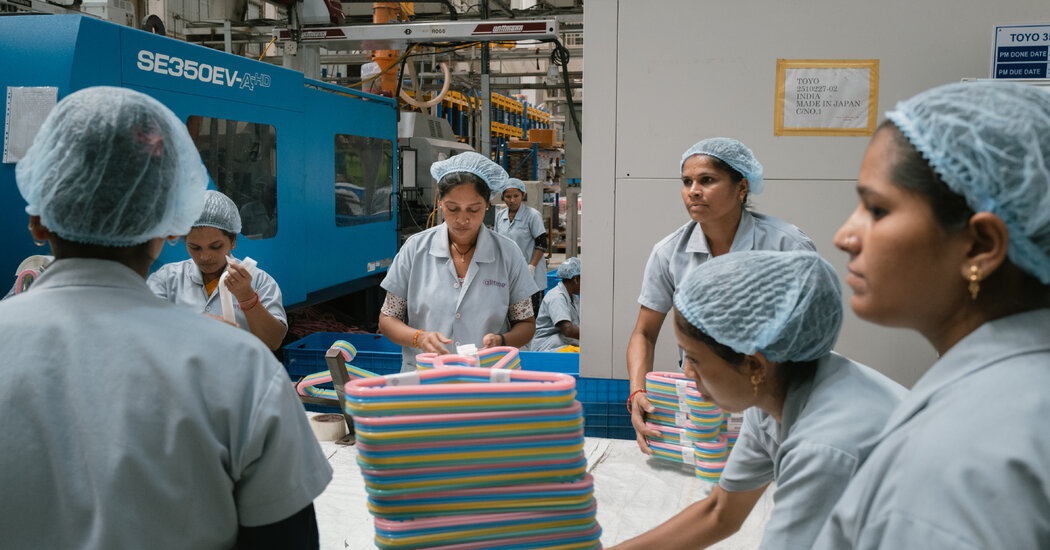Sizing up what President Trump’s new tariffs mean for India was a puzzle from the start for even the country’s top trade economists. Its politicians, too, were stunned.
Starting next week, nearly all Indian goods arriving in the United States will be taxed an extra 27 percent.
The figure was bafflingly high, in part because the government’s ministers had been flocking to Washington since Mr. Trump won re-election. From the Rose Garden, Mr. Trump addressed India’s prime minister, Narendra Modi, in absentia while delivering the disappointing news, calling him “a great friend of mine.” But that wasn’t enough.
The Trump administration, in a White House document, accused India of using “uniquely burdensome” methods to “make it difficult or costly for American companies to sell their products in India.”
The Indian government has been left figuring out how to respond. The country does sell more to the United States than it buys — by about $46 billion last year.
But unlike the other Asian countries that run trade surpluses with the United States, India’s overall balance of trade is negative. It buys more from the rest of the world than it sells. That would make adjusting its trade policies to appease Mr. Trump especially painful.
Its currency was already weakening. Reducing its surplus with the United States would make everything it buys from the rest of the world more expensive.
Because of the new tariffs, some Indian companies will clearly have a harder time selling their products to American buyers. But it is unclear where that pain will land.
Mr. Trump isn’t wrong that India does use trade policies to wall off certain industries. In fact, some Indian economists are hoping that a crisis could force their country to stop using tariffs and other measures to protect its domestic industries from foreign sellers. They reason that more competition might force change and long-term gain. But in the short term, that looks unbearable. Bankruptcies of domestic companies would rise if suddenly forced to compete.
Some hopeful investors noted that, unlike countries that depend on exports, like China or Cambodia, India has a big and relatively untapped base of consumers at home. They could, in theory, replace American customers dissuaded by the higher cost of India’s imports.
“India is domestically a very huge market,” said M.D. Ranganathan, chairman of Catamaran Ventures, a private investment firm in Bengaluru. He says that India’s manufacturers can keep improving even if they are forced to depend more on buyers at home.
Finally, as bad as India is getting it on the tariffs front — nearly all of the countries with which it competes on the world stage are getting it even worse. India has been trying for years, with some success but even more failure, to pick up manufacturing work that’s been leaving China. Countries like Vietnam beat it to the punch. But with Vietnam’s exports looking at 46 percent tariffs, India’s 27 percent seems like an advantage. Whether Indian factories can replace Vietnam’s is a remaining big question.
The other solace: Some of India’s most important exports will escape punishment. Exemptions made for energy products mean that the fuel trade between India and the United States, in which India imports, refines and then exports oil products to America, should not be affected. Likewise, India’s prized pharmaceutical exports will be excluded from the new tariffs. Even its specialized gems trade might find a way to escape. Of course, there is no telling that Mr. Trump will keep to those carve outs; future tariffs are entirely possible.
Textiles may provide another bright spot. India suddenly looks better off than Bangladesh, with 37 percent tariffs, or Sri Lanka, with 44 percent — both nearby neighbors that had learned to outcompete India on low-margin garment manufacturing.
Making iPhones and other electronics in India to sell in the United States will be suddenly much more expensive than it used to be — but, perhaps, suddenly more appealing than making the same things in Southeast Asia.
Ajay Srivastava, a former trade official who runs the Global Trade Research Initiative, a think tank in New Delhi, wrote that Mr. Trump’s full list presents India with an opportunity.
“As global brands seek to diversify supply chains away from high-tariff countries, India can emerge as a preferred destination for new manufacturing setups and component assembly lines,” Mr. Srivastava wrote.
But the same problems that held India back from displacing China in global supply chains in 2022, when Russia’s invasion of Ukraine and Chinese economic problems were making foreign investors talk about “decoupling” or “friend shoring” their factories to other countries, haunt India still.
Despite more than 10 years of a multifaceted program called Make in India, the share of the economy that is industrial has actually fallen to just 13 percent. Services and agriculture claimed larger proportions. India remains a hard place to do business, subject to layers of political interference, and with improved infrastructure — that still falls short of global standards.
Mr. Srivastava is not naïve about the difficulties facing Indian factory managers. He thinks it has made good sense to protect local industries from leaner, meaner competitors. Indian industry, he said, is “like a sick child.” What loving parent would want to pit that kid against global champions?
